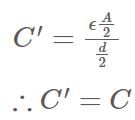DSSSB PGT Physics Mock Test - 1 - DSSSB TGT/PGT/PRT MCQ
30 Questions MCQ Test - DSSSB PGT Physics Mock Test - 1
A ball whose kinetic energy is E is projected at an angle of 45° to the horizontal. The kinetic energy of the ball at the highest point of its flight will be:
[AIEEE 2002]
Two forces are such that the sum of their magnitudes is 18 N and their resultant which has magnitude 12 N, is perpendicular to the smaller force. Then the magnitudes of the forces are
A bomb of mass 4 kg explodes in air into two pieces of masses 3 kg and 1 kg. The smaller mass goes at a speed of 90 m/s. The total energy imparted to two fragments is.
A square plate and a circular plate made up of same material are placed touching each other on a horizontal table. If the side length of square plate is equal to diameter of the circular plate, then the centre of mass of the combination will be
A person standing on a rotating platform with his hands lowered outstretches his arms. The angular momentum of the person
The mass of an electron is 9 x 10-31 kg. It revolves around the nucleus of an atom in a circular orbit of radius 4.5 Å, with a speed of 8 x 105m/s. The angular momentum of electron is
The gravitational force on a body of mass m at a distance r from the centre of the Earth for r < R, where R is the radius of Earth, is proportional to:
The earth attracts the moon with a gravitational force of 1020 N. Then the moon attracts the earth with the gravitational force of
Heat is supplied to the gas, but its internal energy does not increase. What is the process involved?
Which of the following are the extensive variables?
If the r.m.s speed of oxygen at NTP is x m/s. If the gas is heated at constant pressure till its volume is four fold, what will be its final temperature and r.m.s speed?
The path difference between two waves
y1= A1 sin wt and y2= A2 cos (wt + f) will be
The resultant amplitude in interference with two coherent source depends upon _
The necessary condition for phenomenon of interference to occur is
Which one of the following statement regarding electrostatics is wrong ?
When the distance between two charged particle is halved, the force between them becomes
What happens to the capacitance of a parallel plate capacitor when the area of the plates, as well as the distance between them, is halved?
For any charge configuration, equipotential surface through a point is _____to the electric field at that point.
Which of the following statements about earth's magnetism is correct
In the magnetic meridian of a certain place, the horizontal component of the earth’s magnetic field is 0.26G and the dip angle is 60o. What is the magnetic field of the earth at this location
electromagnetic induction i.e currents can be induced in coils (Select the best)
Why is the iron core of a transformer made laminated instead of being in one solid piece?
For a series LCR circuit the input impedance at resonance
A lens of power + 2.0 D is placed in contact with another lens of power – 1.0 D. The combination will behave like
What percentage of the mass of an atom is concentrated in the nucleus?
An electric dipole is placed along the X-axis at the origin O. A point P is at a distance of 20 cm from this origin such that OP makes an angle π/3 with the X axis. If electric field at P makes an angle θ with X-axis, the value of θ is
































